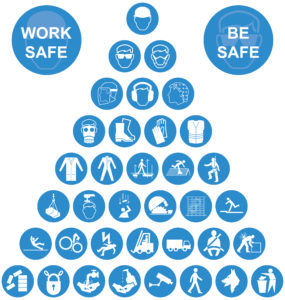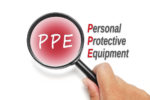 PPE or personal protective equipment comes in many designs and uses. During a risk assessment, the need for personal protective equipment or PPE is identified and which type is best suited to be used. PPE is equipment that is used by the employee to directly protect them from harm or discomfort while at work. PPE can also improve the way things are done by making it more comfortable to work.
PPE or personal protective equipment comes in many designs and uses. During a risk assessment, the need for personal protective equipment or PPE is identified and which type is best suited to be used. PPE is equipment that is used by the employee to directly protect them from harm or discomfort while at work. PPE can also improve the way things are done by making it more comfortable to work.
There are many different types of PPE to protect different parts of the body and what you will need will be advised by your employer. When your employer provides you with PPE you must wear it and keep it well maintained.
If the PPE is damaged it is no longer effective and can become a risk itself and cause you harm. Report any damages and do not use damaged or PPE that does not fit you.
The different types of PPE and some of the more common items include:
- Head protection – this can be in the form of a hard hat or a re-enforced cap to protect you against items that may fall or if you hit your head against something. They must be adjusted inside to make sure that the supports fit your head. Some also have visors on to protect your eyes or earmuffs to protect your hearing.
- Ear defenders – these protect your hearing from short and long-term hearing damage. They can be in the form of foam plugs that go in your ear to the full defenders that go over your head or attached to a hard hat.
- Overalls – these prevent loose clothing getting entangled, keep you clean, prevents contamination that transfer on clothes and some are made of a material that resists fire or chemicals. Where necessary, high visibility strips are sewn into the overalls to make you more visible to others.
- Cold weather clothing – this protects you from the cold and rain which can prevent accidents by making you more comfortable. Some safety items are incorporated as well as protective strips or high visibility strips.
- Gloves – there are many types of gloves to protect from infection from blood, chemicals, to protect from sharp items, to keep you warm, to give more grip and to keep you dry.
- Footwear – this can be wellington boots or work boots and these sometimes have steel toe caps to protect you if something is dropped on your foot. Footwear is also designed to have features like good grip to avoid slips and resistance to chemicals.
- High visibility clothing – this can be coats, overalls, vests or armbands. These make you more visible to people and drivers of vehicles.
- Breathing equipment – this can be a complex face mask and breathing apparatus with a simple mouth and nose paper mask. These avoid dust particles entering your respiratory system. Any mask or respirator must be well maintained and the mask or filters changed when needed.
- Safety goggles or glasses – these prevent dust, dirt or liquids getting into your eyes which can irritate or damage your sight.
- Safety harnesses – if you are working at heights or in dangerous areas you may have to wear a safety harness. You will need special training on harness use as if they are not worn correctly, they can be ineffective.
- Lifejackets – if you are working near or on water, it may be necessary to wear a lifejacket in case you fall into the water. There are many other types of PPE, talk to your employer on what you need to use while at work.

Pingback: Lead does not come under the COSHH regulations, separate regulations
Pingback: Infection Control n the workplace is a concern in many workplaces
Pingback: PUWER is the Provision and Use of Work Equipment regulations 1998
Pingback: Asbestos is the single greatest cause of work-related deaths in the UK
Pingback: Working at Heights pose risks no matter how high or low you are working
Pingback: Water extinguisher use demonstration available on our courses
Pingback: Lyme disease is a dangerous disease and it can be carried by ticks
Pingback: A hazard is anything with the potential to cause harm like a cutting machine
Pingback: Motorised Lifting Aids products the workplace forklifts and motorised lifting
Pingback: Control measures, a mixture of equipment, ways of working to reduce risk